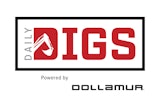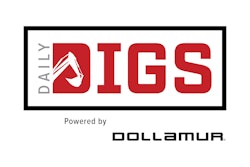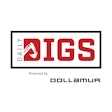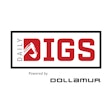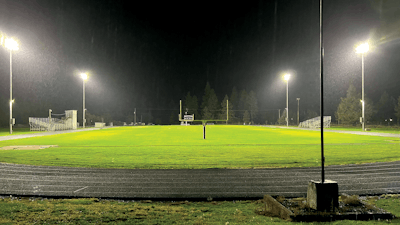
In the 10 years since Athletic Business first looked at light-emitting diode technology as a large-scale sports lighting solution, LEDs have revolutionized the way we illuminate just about everything — from 100,000-seat football stadiums to Little League baseball diamonds to dining room tables.
The advantages are undeniable. LED sports lighting is superior to its predecessors in that it provides instant on-off and dimming capability (which comes in handy during pregame lineup introductions), special effects capability such as color-changing, flickering and racing lights (to celebrate big plays and wins) and color temperature adjustment capability to accommodate, say, the lighting of a hardwood basketball court versus an ice rink in arenas that serve both sports.
And while energy efficiency is a key driver to LED adoption in applications both dynamic and domestic, it’s the precision with which manufacturers and installers can direct this point-source technology that has elevated sports lighting design to much more of an exact science compared to the relatively scattershot days of high-intensity discharge lamps. As one manufacturer puts the past decade of design development, “We learned we have to light things on purpose.”
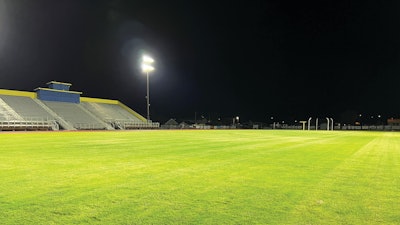 Photo courtesy of Slatercom
Photo courtesy of Slatercom
Design basics
Several factors make the lighting of sports fields a complex endeavor. These include the number and height of poles, the number and wattage of fixtures, the angles at which individual fixtures are aimed and the angles at which light leaves individual fixtures. These can vary from project to project and within the same project, all with the goal of achieving uniformity of lumens delivered to the playing surface.
Beam spreads — the aforementioned angle at which light leaves the fixture — can be as narrow as 10 degrees, which throws light farther as a “spot” than the widest “flood” angles that exceed 100 degrees, according to classifications established by the National Electrical Manufacturers Association.
“Let’s say it’s a high school field, and you have 10 lights per pole,” says Mike Slater, sales manager at Slatercom Lighting Solutions, which designs fields using products from several different lighting manufacturers. “You might have six 40-degree beams. You might have two or three narrow beams — 15 degree. And you might even have a 60 in there, because you have to use a wider beam when you’re lighting closer to the pole, and especially at a lower height, because otherwise you put a hotspot on the ground — so you want the light to leave at a wider angle, instead of a narrow angle.”
Controlling beam angles from LED fixtures involves taking direct light from a diode in the fixture and shaping it through a lens. “LEDs, by their own kind of natural characteristic, are directional. Light just comes straight out,” Slater says. “A lot of the manufacturers use a lens that has what look like little bubbles on the lens, but those are the mini-lenses, if you want to call them that, that actually are designed to be right in front of a particular diode and refract that light in the beam angle that you’re looking for.”
Says James McCarty, president of Midstream Lighting, “You start to think more about what’s possible with this light source. We have an optical system that we have developed that creates symmetric and asymmetric beam distributions — beam types — so that we can be more efficient, use fewer fixtures and have tighter uniformity. And by having the additional asymmetric beam shapes, it allows us to fill in those spaces in a way that’s much more efficient than the old, traditional NEMA one through seven linear beam types.”
The competition requirement in Slater’s high school football example might be to have an average of 30 foot-candles (measured 36 inches above grade) everywhere on the field, though Slater prefers to shoot for a minimum of 30. Even more important to Slater is an installation’s uniformity ratio — how many times brighter the brightest spot on the field is compared to the dimmest. “We shoot for less than two-to-one, and we try to get one-and-a-half-to-one anytime we can,” he says. “That just makes the fields look so much better, and the athletes actually appreciate it.
“I tell people all the time, I would rather have less average foot-candles, and have them really even on a field than have a much higher average foot-candle. The danger of just going off average foot-candles is, if you need 30, you could have 60 foot-candles in one spot and zero — no light — in another and still meet a 30-foot-candle average,” adds Slater, admitting to using an extreme, and rare, scenario to make his broader point. However, he says that a three-to-one ratio is “not uncommon” in his experience of reviewing projects. At that point, the field “does not look good” to the naked eye, and can actually start to impact, for instance, a receiver’s ability to track a pass. Says Slater, “They may not be consciously thinking about it, but their eyeballs and brain are having to fight with this.”
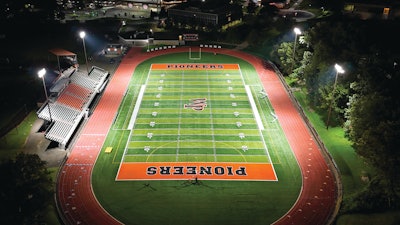 Photo courtesy of AEON
Photo courtesy of AEON
Lighting above and beyond
Purposefully lighting a playing surface is one thing, but design gets trickier when trying to create vertical foot-candles above the surface without throwing light where it doesn’t belong — namely, into neighboring property. LEDs have made it easier.
“With the old HID lighting systems, because of the nature of the bulbs blasting light in every direction, we couldn’t really have very good vertical foot-candles, because if you started to tilt that fixture head up, then you blasted light to the neighbors or the roads or wherever else,” says McCarty, whose company’s optics actually shape beams to fit together better on a field. “Imagine putting a puzzle together. When you’re putting the puzzle pieces together, you want to do it as efficiently as possible, with as few puzzle pieces — in this analogy, fixtures — as possible.”
On a high school football field, lighting design typically entails two poles, holding 10 fixtures each, on both sides of the field. The fixtures on each pole would generally serve the quadrant of the field closest to it, but the specification of the fixtures themselves, as well as their beam angles, is where the system can be tweaked. If a street runs parallel to one side of the field, with residences located across that street, the lights facing those residences from the far sideline can exhibit tighter beams to combat glare and spill across the field and into those private properties. On the sideline nearest those homes, where the lights face away, broader angles can be specified to create the desired delivery of lumens to the field.
On a high school or municipal baseball diamond, which might employ more poles and fixtures to reach a target 50 foot-candles on the infield and 30 in the outfield, ball tracking is every bit as important. Not only is the ball smaller, it travels faster and higher through the night sky. Lighting designs are likely to involve taller poles with enough fixtures and beam patterns angled in such a manner as to illuminate the sides and bottom of the ball in flight. Despite its deep green and brown coloring, a baseball diamond — like any field — will reflect some light, but vertical foot-candles from reflection only go so far. The key is to have some light on the ball throughout its arc, so that the fielder never completely loses sight of it — even at its apex. LED lenses can be designed to not only direct light to the field, but also deliver vertical foot-candles without encroaching on neighboring properties.
“Most of the time on high school fields we’re running about 70-foot poles, so the ball will travel even higher than the poles, potentially,” Slater says. “But the thing is, you have reflected light, and we like to have some broader-angle fixtures that will throw some to the ground, but also throw it outwards a little bit, too. We’ve designed into the photometric design just enough light horizontally that it’s catching the side of the ball and bottom of the ball.”
Horizontal foot-candles can be measured using handheld meters positioned 3 feet off a field. Vertical foot-candle measurement requires design software. Slater estimates that as long as the bottom of a ball that is hit 100 feet above the ground is in even 5 foot-candles of light, “That’s plenty to see at nighttime, and that’s at the apex. It’s going to get brighter the more it returns to the field of play.”
With more high school events being streamed live, ball tracking can even come into play when considering remote viewers. “We can create a lighting design that’s not offensive to the neighbors and still gives you a good amount of vertical foot-candles for streaming,” McCarty says. “In the old days with HID bulbs, we were only concerned with horizontal foot-candles. That’s where the focus was before. Now we still design to that, but because of the precision of LEDs, and the cut off, we now can also increase the vertical light levels, which is great for aerial sports. There’s a lot more passing in football than there used to be. Certainly, lacrosse has the speed of the ball. Same thing with baseball.”
And as LED technology use has proliferated nationwide, from stadiums to street lights, greater attention has been paid to its collective effect on the night sky.
“There are some manufacturers out there that have to use uplights, because otherwise how is a ball that’s in the air illuminated?” Slater says. “You have a tight beam with no trespass to the neighbor across the street, but then you have to shoot light straight up in the air, which probably isn’t bugging the neighbor across the street, but it’s leading directly to the light pollution in the sky for people who like to look at the stars.”
Slater feels designers can get too tight with their designs, to the detriment of those attending events. “It almost sterilizes the field, meaning that the field is super bright, and as soon as you get just off the field, it’s dark,” he says. “Well, that’s created issues for some athletic venues, and I know this because I’ve heard from them. Now their stands are dark, and there’s no tertiary light that’s kind of spilling off just a little bit in order to have some light for folks to walk around.
“There’s kind of a fine line, and what we shoot for when we do our photometrics is we want to see, of course, the lighting performance that’s needed for the field, but we want to see some off the field. We really do, but the foot-candles of light hitting the ground should be falling away fairly quickly.”
How quickly? If there are 30 foot-candles on a high school football field, Slater recommends a drop to 15 foot-candles in the stands (suitable for navigating bleachers and reading game programs) and on the surrounding running track. “I like to see the foot-candles drop off to zero by the time we get to the fence line of that particular venue and off the school property,” he adds. “You have to have the fixtures with the multiple beam angle offerings to do that. I mean, you may have a pole that has three different beam angles on it to accomplish the design that you’re trying to do.”
According to McCarty, manufacturers seek the satisfaction of three constituencies with every lighting design — the sports participants, the spectators and the surrounding neighbors, in that order. “Those are generally the stakeholders that we’re dealing with,” he says. “It’s about balance. You can have the right amount of light for the players, you can have the right amount of light for the spectators, and you can have the right amount of light that doesn’t impact the neighbors. It’s not either or. In the old days, with all the hoods and visors and hyperfocus on off-site spill and glare, you gave up something. And, often, you gave up a lot. We believe that with LED being a point source, and with the right beam distributions, that we can satisfy all three without giving up anything.”
Both Slater and McCarty make site visits before embarking on a given project, then there’s the design phase, and finally installation and onsite adjustments. It’s that middle sequence — design — that’s most key, and LED technology brings a precision to the process never before realized in the sports lighting industry.
“It allows you to customize,” McCarty says. “It’s a tailored suit, right? Not one off the rack. The LED technology allows you to design with the different beam distributions, and I think that’s the difference.”
















